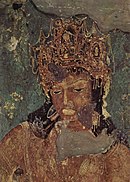
Back বাকাটক রাজবংশ Bengali/Bangla Vakataka Catalan Vakataka German Vakataka dinastio Esperanto Dinastía Vakataka Spanish Vakataka Finnish Vakataka French વાકાટક વંશ Gujarati שושלת וקאטאקה HE वाकाटक Hindi
Vakataka dynasty | |||||||||||||||||||
|---|---|---|---|---|---|---|---|---|---|---|---|---|---|---|---|---|---|---|---|
| c. 250 CE – c. 510 CE | |||||||||||||||||||
Approximate extent of the Vakataka territories circa 350 CE.[1] | |||||||||||||||||||
| Capital | Vatsagulma (Now Washim) | ||||||||||||||||||
| Common languages | Sanskrit Maharashtri Prakrit | ||||||||||||||||||
| Religion | Hinduism Buddhism Jainism | ||||||||||||||||||
| Government | Monarchy | ||||||||||||||||||
| Maharaja[2] | |||||||||||||||||||
• 250–270 | Vindhyashakti | ||||||||||||||||||
• 270–330 | Pravarasena I | ||||||||||||||||||
• 480–510 | Harishena | ||||||||||||||||||
| Historical era | Classical India | ||||||||||||||||||
• Established | c. 250 CE | ||||||||||||||||||
• Disestablished | c. 510 CE | ||||||||||||||||||
| |||||||||||||||||||
| Today part of | India | ||||||||||||||||||
| Vakataka dynasty c. 250 - 510 CE | ||||||||||||||||
|---|---|---|---|---|---|---|---|---|---|---|---|---|---|---|---|---|
|
||||||||||||||||
| Nandivardhana-Pravarapura Branch | ||||||||||||||||
|
||||||||||||||||
| Vatsagulma Branch | ||||||||||||||||
|
||||||||||||||||
The Vakataka dynasty (IAST: Vākāṭaka) was an ancient Indian dynasty that originated from the Deccan in the mid-3rd century CE. Their state is believed to have extended from the southern edges of Malwa and Gujarat in the north to the Tungabhadra River in the south as well as from the Arabian Sea in the west to the edges of Chhattisgarh in the east. They were the most important successors of the Satavahanas in the Deccan and contemporaneous with the Guptas in northern India.
Little is known about Vindhyashakti (c. 250 – c. 270 CE), the founder of the family. Territorial expansion began in the reign of his son Pravarasena I. It is generally believed that the Vakataka dynasty was divided into four branches after Pravarasena I. Two branches are known, and two are unknown. The known branches are the Pravarapura-Nandivardhana branch and the Vatsagulma branch. Gupta Emperor Chandragupta II married his daughter into the Vakataka royal family and, with their support, annexed Gujarat from the Saka Satraps in 4th century CE. The power vacuum left by the Vakatakas were filled by that of the Chalukyas of Badami in the Deccan region.[3] The Vakatakas are noted for having been patrons of the arts, architecture and literature. They led public works and their monuments are a visible legacy. The rock-cut Buddhist viharas and chaityas of Ajanta Caves (a UNESCO World Heritage Site) were built under the patronage of Vakataka king, Harishena.
- ^ Schwartzberg, Joseph E. (1978). A Historical atlas of South Asia. Chicago: University of Chicago Press. p. 145, map XIV.1 (i). ISBN 0226742210.
- ^ Singh, Upinder (2008). A History of Ancient and Early Medieval India: From the Stone Age to the 12th Century. Pearson Education India. p. 482. ISBN 978-81-317-1677-9.
Pravarasena I was the only Vakataka king with the imperial title samrat; the others had the relatively modest title maharaja.
- ^ Ancient India, A History Textbook for Class XI, Ram Sharan Sharma, National Council of Educational Research and Training, India, pp 211



